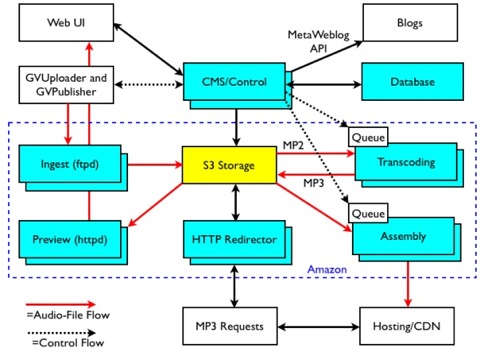Using Amazon Web services podcast

In the latest Technometria podcast at IT Conversations, Scott Lemon, Matt Asay, and I speak with Jeff Barr and Doug Kaye about using Amazon Web Services to build sophisticated applications. Jeff is Amazon's evangelist for Web services and Doug is the founder of IT Conversations and now the CTO for GigaVox Media.
Doug just finished building a large application for hoteling podcasters. I wrote about Doug's application a few weeks ago on Between the Lines. Here's Doug's architectural diagram:
Transcoding all that audio (and someday video) takes a lot storage, bandwidth, and, most of all, processing power. In a normal start-up, Doug would have spent hundreds of thousands of dollars building an infrastructure to support the business model. In this case, Doug spent less than $1000.
The real power of this model comes from understanding the simple idea that computing on demand moves fixed costs to operational costs. Scaling doesn't just apply to technology, it applies to business models as well and this allows business plans to scale. Using computing on demand, a business could be in the black much sooner than with traditional computing platforms. Add the additional simplicity of not having to have staff on hand to manage that infrastructure and you've got a real win.
Of course, this model isn't for everything. Doug makes the point in the podcast that EC2 isn't a good platform for databases. We also talk about how the programming style changes to support asynchrony--something most programmers aren't used to dealing with to any great degree.
The best part of being Executive Producer of IT Conversations is getting to be part of great conversations like this one. I hope you enjoy listening to it as much as I did doing the interview.
